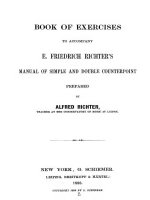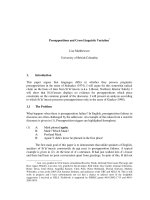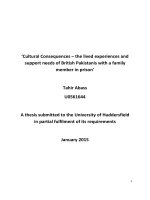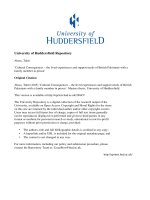Manual of British Grasses, Gordon 1907
Bạn đang xem bản rút gọn của tài liệu. Xem và tải ngay bản đầy đủ của tài liệu tại đây (22.57 MB, 253 trang )
3^
67W
MANUAL
OF
^•British Grasses.
BY
W.
J.
GORDON,
AUTHOR OF "OUR COUNTRY'S FLOWERS," ETC.
WITH A COLOURED ILLUSTRATION OF EVERY SPECIES
AND MANY ORIGINAL DIAGRAMS BY
J.
T.
GORDON.
^THSONMaT
FEB
3 1988
LONDON:
SIMPKIN, MARSHALL, HAMILTON,
KENT &
CO., Ltd.
PREFACE
r
"HE word
I
-*
grasses
is
used in this book in
its strictest
forage plants, nor in
as in the Bible
original
its
meaning
Graminese.
The
order, in
which
common herbage
of
and consequently several
;
the true grasses are grouped,
all
contains about 3,600 species, and of these
hundred or so said to be native to our islands
we
deal with the
for the usual reason
Some may
that the dates of their introduction are unknown.
arrived
the
during
historic
period,
some may
originated here, but none are confined to our area
there
is
popularly
grasses,
do not belong to the
so called, do not appear herein as they
have
sense and
not as a farmer would use it as including the clovers and other
;
in
have
which
nothing remarkable considering the ease and frequency
with which grass seeds are distributed.
For
its
food plants no botanical order
is
of greater interest
nor has any been more written about, some of the books being
really
wonderful
many,
for
verification
illustrated
the labour they involved.
for
instance, to
of
the
which
materials
I
of
by actual specimens
Among
have been indebted
this
is
Hanham's, which
of the plants,
naively apologises for the delay in
its
his collection
!
the
is
and the author
production on account
of the difficulty in selecting 60,000 suitable examples
mass of
in
the
from the
Only those who have had to deal with
PREFACE.
vi
a collection of their
set
himself.
own can adequately
And snch
collectors
realise the task
are increasing
in
he
number,
owing to the economic importance of the subject, helped by
the grasses remaining as
flowers
plentiful
become scarcer every
That the
species
may be
as
year.
quickly distinguished, a somewhat
similar plan has been adopted to that in "
the
name
of the plant being
could be devised
group alone
description.
—though
ever while other wild
Our Country's Flowers,"
found by the shortest method that
may
it
—the identification
hold good for the British
being confirmed by the detailed
Hence more attention than usual
is
given to the
vegetative and other external characters.
The
by
illustrations
have
all
been specially drawn for the work
my son. They include a complete series
of a
hundred and one
coloured figures of the plants, and over eighty diagrams of the
structure of their flowers.
W.
J.
G.
CONTENTS.
CHAPTER
I.
II.
PAGE
Introductory
i
List of British Grasses
.
.
.
.
,
n
III.
Customary Names
20
IV.
British Cereals
26
V.
The Order and
VI.
VII.
VIII.
IX.
its
Tribes
37
....
The Tribes and their Genera
The Genera and their Species
.
Tabular View of British Grasses
The Seeds of the Grasses
.
.
.
.
.
.
.
.
43
65
.139
.152
X.
Index to Species
161
XL
Index to Genera
172
Index to Customary Names
174
XII.
COLOURED PLATES
FIGURES!
PLATES.
I.
II.
Cut Grass
i
Millet
2
Finger Grasses
3,
4
6,
7
.
Rough Bristle Grass
III.
IV.
5
Bristle Grasses
Cockspur
8
Holy Grass
Vernal Grass
Canary Grass
Reed Grass
9
.
.
.
.
.
.10
11
12
.
V.
Timothy
13
Alpine Cat's-tail
VI.
VII.
VIII.
14
Cat's-tail Grasses
Foxtail Grasses
Knappia
.
18, 19, 20, 21
.23
Beard Grasses
IX. Bent Grasses
24, 25
26, 27, 28,
Nit Grass
29
30
Marram
XI.
22
.
Hare's-tail
X.
15, 16, 17
:
Smallreeds
31
32, 33, 34, 35
XIII.
Hair Grasses
Hair Grasses
38, 39,
XIV.
Oat Grasses
41, 42, 43
XII.
36, 37
viii
40
COLOURED PLATES.
PLATES
XV.
ix
.......
FIGURES.
False Oat Grass
Soft Grasses
XVI.
XVII.
XVIII.
XIX.
45,
46
Dog's Tooth
47
Cord Grass
48
Hard Grass
Mat Grass
Lyme Grass
49
50
51
;
Barley Grasses
Couch Grass
52, 53, 54, 55
56
Wheat Grass
Rye Grass
58, 59
False Brome Grasses
60, 61
XX. Brome Grasses
Brome Grasses
XXI.
XXII.
Fescue Grasses
XXIII.
Fescue Grasses
XXIV.
44
57
62, 63, 64, 65
66, 67, 68
.
.
.
.
.
.
69,
.
Cock's-foot
74
Dog's-tail Grasses
XXV. Quake Grasses
XXVI. Meadow Grasses
XXVII. Meadow Grasses
Meadow Grasses
XXIX. Meadow Grasses
XXX. Meadow Grasses
XXXI. Whorl Grass
XXVIII.
Flying Bent
XXXII. Melic Grasses
Heath Grasses
XXXIII. Koeleria
Blue Moor Grass
Reed
70
71, 72, 73
.
.
75> 76
.
.
.
.
.
77,78
.
.
.
79, 80, 81
.
.
.
.
....
82, 83,
84
85, 86, 87
88, 89,
90
91 92, 93
,
94
95
96,97
98
99
100
101
ILLUSTRATIONS IN TEXT.
PAGE
Panicle
2
-
Spike
3
Diagrammatic Spikelet
Agropyrum repens,
60
Spikelet
65
„
„
4
Floret
Agrostis alba, Floret
46
Spikelet
,,
,,
•
Aira caryophyllea, Floret
Spikelet
„
,,
Alopecurus agrestis,
„
,,
.
44
Spikelet
73
Floret
63
Spikelet
76
„
Arrhenatherum avenaceum,
„
,,
Arundo phragmites,
Avena
Spikelet
,,
,,
Briza minor, Floret
Bromus giganteus,
,,
,,
78
.
Floret
Spikelet
.
....
Spikelet
,,
,,
77
....
Brachypodium sylvaticum,
,,
49
Spikelet
52
Spikelet
pratensis, Floret
,,
Floret
Floret
,,
,,
72
.
Floret
Anthoxanthum odoratum,
,,
67
48
Floret
49
80
58
81
54
83
.
57
Spikelet
88
ILLUSTRATION'S
Calamagrgstis EPIGBIOS, Floret
Spikelet
Catabrosa aouatica. Florer
Spikelet
Cyxodox DACTYix
x.
Floret
Spikelet
Cyxosurus CRI5TATU5. Floret
Spikelet
Dactvlis glomerata. Floret
„
Spikelet
,,
DlGRAPHIS ARUXDIXACEA, Floret
Spikelet
,,
Elymus arenarius,
Floret
Spikelet
.,
Festuca ovixa.
Fl<
Spikelet
Gastridium lexdigerv
„
ret
Spikelet
,,
Hierochloe borealis, Floret
„
„
Spikelet
.,
Holcus LANATUS,
Floret
Spikelet
,,
Hordeum marixum,
„
,,
.
Floret
Spikelet
KOELERIA CRISTATA, Floret
„
„
La gurus o vat us,
„
Spikelet
Floret
Spikelet
,,
.
Leersia oryzoides, Floret
„
Spikelet
„
Lepturus incurvatus.
„
„
Floret
Spikelet
IN
TEXT.
ILLUSTRATIONS IN TEXT.
Lolium perenne,
Floret
Spikelet
„
„
.
Melica uniflora, Floret
„
Spikelet
99
Mibora verna,
Floret
Spikelet
„
,,
Milium effusum, Floret
Spikelet
„
,,
Molinia c^erulea, Floret
,,
.
.
Spikelet
,,
Nardus
stricta,
,,
„
Ovary and Stigma
Spikelet
.
Panicum viride, Floret
Spikelet
„
,,
.
Phalaris canariensis, Floret
Spikelet
„
„
Phleum pra tense,
Spikelet
„
,,
Poa pratensis,
,,
"Floret
Floret
Spikelet
,,
POLYPOGON LITTORALIS, Floret
,,
Spikelet
„
,,
PSAMMA ARENARIA,
Floret
Sesleria C/erulea, Floret
„
.
Spikelet
„
,,
.
Spikelet
Spartina stricta, Floret
,,
,,
Spikelet
Triodia decumbens, Floret
? ,
,,
Spikelet
^CHAPTER
I.
INTRODUCTORY.
WE
will begin
by taking a
grass in
name as quickly as we can.
is
not a grass but a sedge, and
The stem
difficulty at once.
generally triangular
and never
;
we may
The
its
as well get over that
of a sedge
that of a grass
three-sided.
bloom and arriving at
Perhaps, however, our specimen
is
is
always solid and
generally hollow, rounded,
leaves of a sedge are in three ranks
those of a grass are alternate in two ranks.
;
In both, the leaves em-
brace the stem with sheaths, but in grasses the sheaths are nearly
always
while in sedges they are not.
split,
leaf -blade joins the
is
more or
known
less
further, where the
sheath in grasses the inner side of the sheath
prolonged into a sort of membranous edging
as the ligule, whereas a sedge has no ligule.
There are other
distinctions
we may
deal with later on,
but we have enough to make sure that we have a grass and
not a sedge for the stem is round and hollow, the leaves are
alternate in two series, the sheath is split and there is an un;
mistakable
ligule.
How
about the inflorescence, that is the arrangement of
the flowers on the stem ? Is it a spike, that is having the flowers
attached to the axis without a pedicel or stalk to each ; is it a
raceme in which the pedicels are the primary branches or is it
;
a panicle in which the flowers grow on the secondary or remoter
For our present purpose we need not trouble ourand we can assume that what looks
like a spike is really a spike, though closer inspection may show
it not to be strictly within the definition
Dealing with them
in this oil-hand way, wc shall find that there is no difficulty in
branches
?
selves regarding the raceme,
.
INTRODUCTORY.
sorting out the inflorescences of all our British grasses into either
Let us agree then that it is a panicle, as it
very strictest sense.
Having advanced so far we will eliminate a few exceptions
from the group. Is the sheath quadrangular and not split ?
spikes or panicles.
undoubtedly
No.
Then
red veins
?
is
its
in the
genus
No.
is
Then
not Melica.
it is
sheath white with
Are the leaves glaucous
Is the
not Holcus.
above and dark green underneath ? No. Then it is not Triodia.
Is the stem solid and bent at the only node ?
No. Then it is
not Molinia. Are its spikelets orbicular ?
But what
which
is
a spikelet
?
That
often called the flower of
is
the grass, consisting of a pair of
known as glumes, which enone or more flowers, better
bracts
close
called
placed
florets,
one
(rachilla)
on an axis
above
the
other
alternately, each floret being, typically, enclosed in
\m w
imp
"""^vAIJ/
another pair of
own.
It would have saved obscurity
bracts of
in
many
its
botanical descriptions of
the grasses
each of these four
if
the
lower
upper
pair,
had
special
name.
bracts,
and the
pair
been
given
Even the
a
old plan
of calling the upper pair glumellas
was
Panicle.
better
fashion
in
than
the
prevailing
which
the
higher
the upper pair
is
of
the palea, the
next the flowering glume or fruiting glume, and the lower pair
•the
glumes, with inevitable references to the upper glume and
the lower glume and a consequent doubt as to whether barren
glume or flowering glume is meant. To avoid trouble of this
sort, the lower pair have in this book been spoken of as glumes
and the upper pair as paleae, the lower glume being called the
outer glume, the upper the inner glume.
The lower palea
(that
INTRODUCTORY.
is
and the upper
the flowering glume) being the outer palea
of
the pair the inner palea.
The beginner
to deal with at
linds the flowers of the grasses rather
first,
The best
ing glass and too large for the microscope.
by a
afforded
awkward
as they are too small for the ordinary magnify-
aid
is
dissecting microscope of low power, but a glass
answers every purpose if magnifying rather more than the usual
run of such things.
Anyhow a lens of some sort is essential,
though
in this particular case
spikelet
is
further that
it
spikelet
glass, too,
has
but
that helps us much,
feel
see without
is
it
that the
not Briza
— and
has glumes, and consequently cannot be Leersia.
Without the
each
we can
—wherefore the genus
not orbicular
but better with
one
we have only
for
it,
we can
see that
And
floret.
to
the leaves whether they be smooth or
rough, and finding
them smooth and broad
Milium without
further ceremony.
As there is only one
species of Milium in the British flora, the
grass must be M. effusum, the Spreading
Millet, as we might have guessed from its
height and from our meeting with it in our
we know
the genus to be
walk through the woods.
Let us, however, with the aid of the
glass, open up this spikelet and compare
it with a
diagram in which the typical
arrangement of the florets is shown.
Lowest of all we have the outer glume,
slightly
up
the
above and opposite to
rachilla
opposite.
is
the
outer
it
is
the inner glume.
palea
Within the paleae more or
—
Spike.
with the
less
Higher
inner
we have
the
palea
pistil
—
with the lodicules in this case two at the base, and round it
is the whorl of
three stamens, the first placed just above
the outer
palea, and often rather larger than the others,
stamen with a longish filament carrying the double
notched anther.
In one British genus, Anthoxanthum, there
each
are
only
two stamens
;
in
some genera,
all
foreign,
there
INTRODUCTORY.
4
may
be only one, as in Cinna, or
thirty,
as
The
in
pistil
six,
as in
Oryza,
or even
Ochlandra.
contains a single ovary with a single ovule and
two styles on which are the stigmas, feathery (plumose)
form as affording a large catchment surface for the pollen
shed by the adjoining anthers or carried by the wind from
anthers of other flowers. Sometimes, as in Nardus, there is but
carries
in
Ovary
Outer
Palea.
Inner
Glume
Outer
Glume
.
Rachilla.
Diagram of Spikelet.
sometimes there are three, as in Megalachne of Juan
Fernandez sometimes, as in Briza, there is a rudimentary third.
Let us take another panicle. Finding that the grass is not
one of the six already mentioned (Melica, Molinia, etc.), we count
the florets in the spikelet and find that there are three or more,
and that they bear awns, these being the stiff bristles which in
If there had been only two florets, both
cereals form the beard.
complete, the genus would be Air a if two with the lower without
one style
;
;
;
INTRODUCTORY.
5
any pistil, it would be Arrhenatherum. But it has several florets.
Then if the panicle be tufted it can only be Dactylis (Cocksfoot)
but it is gracefully diffuse, and we can tell it by its awn. Is
the awn terminal, that is, does it start from the apex of the outer
palea ? No. Then it is not Festuca.
Does it start from just
below the apex, that is, is it sub-terminal ? No. Then it is
not Bromus. Is it dorsal, that is, does it start from the back ?
Yes. Then it is Avena. But which species ? Are the spikelets
No. Then
erect and the ligule truncate, that is, cut off short ?
it is not the Yellow Oat.
Are the spikelets erect and the ligule
pointed ? No the spikelets droop, the ligule is short, and the
species is the Wild Oat, A. fatua.
;
;
Now
let
us take a spike.
Is it digitate, that
is, is it
a group
No. Are the spikelets placed
stem ? Yes. Are they in ones,
twos, or threes ? Threes. Then the genus is Hordeum.
If they
had been in pairs, it would have been Elymus ; if in ones, either
Nardus, Lepturus A g ropy rum, or Lolium. The one style (instead
of two) distinguishes Nardus ; the axis jointed at each notch
marks off Lepturus ; the spikelets close together characterise
Agropyrum, as the spikelets with well-marked intervals between
indicate Lo iu n.
Next we will have a spike in which the spikelets are not in
notches.
Are the spikelets on one side only ? No. Then the
genus is neither Cynosurus in which the spikelets are rounded, nor
Spartina in which they are flattened. Are the spikelets alternate
No. Is the spike ovoid, that is, almost
in two opposite rows ?
of spikes, diverging like fingers
?
in little cavities or notches in the
globular
?
No.
Then
it is
neither Phalaris nor Lagurus.
the spike taper from the base upwards
that
is,
spindle-shaped, or cylindrical
Let us make sure.
that
is
bifid
?
No.
Is the ligule
Then
interrupted near the base.
it
is
No.
?
?
No.
Does
Is it fusiform,
Yes, probably cylindrical.
very long and
not Psamma.
Then
it
is
cleft into
Is
two,
the spike
not Koeleria.
Is
rounded ears and are
there only two anthers ? No. Then it is not Anthoxanthum
Are the spikelets imbricated, that is do they overlap one another
like the tiles on a house ?
No, Then it is not Sesleria. Is the
the base of the leaf auricled, that
is,
has
it
;
INTRODUCTORY.
6
Then it is not Alopecurus
No, it is bristly.
?
Are the spikelets compressed laterally or dorsally ?
Then it is Phleum, and probably our old friend
Laterally.
Timothy, which we can easily ascertain by a reference to our
tabular arrangement of that genus. The spike is long and
cylindrical
the glumes are neither wedge-shaped nor tapering,
they are truncate, and with that and the thin, white ligule toothed
at the apex, Phleum pratense, otherwise Timothy, is unmistakably
spike silky
(Foxtail).
;
indicated.
need not identify at length every genus in the list. We
have had examples enough to show the working of the key which
it is time to give.
We
Spikes digitate.
Cynodon.
Spikelets in ones.
Pant cum (as regards P. s (inguinale
and P. glabnim, frequently grouped into Digitaria).
Spikelets in pairs.
Spikes not digitate.
Spikelets in notches.
Spikelets in ones.
Spikelets on one side only but in 2 alternate rows.
Only one
style.
Nardus.
Axis jointed at each notch.
Spikelets close.
Lolium.
Spikelets distant.
Spikelets in pairs.
Lepturus.
Agropyrum.
Elymus.
Spikelets in threes.
Hordeum.
Spikelets not in notches.
Spikelets on one side only.
Spikelets flattened.
Spar Una.
Spikelets not flattened.
Cynosurus.
Spikelets alternate in 2 opposite rows.
Leaves channelled and blunt. Mibora.
Leaves flat and acute. Festuca (as regards F.
turning to one side.
Spikelets
loliacea).
Poa
loliacea).
(as regards
P.
INTRODUCTORY.
7
Spike ovoid, almost globular.
Spike smooth.
Phalaris.
Spike with long, silky hairs.
Lagurus.
Spike tapering from base.
Spikelets flattened.
Polypogon.
Spikelets not flattened.
Gastridium.
Spike fusiform or cylindrical.
Psamma.
Ligule lengthy and bifid.
Ligulc not lengthy and
bifid.
Spike interrupted near base.
Koeleria.
Spike regular.
Leaf base with rounded ears (anthers
anthum
Spikelets imbricated, colour bluish.
Spike
2).
Anthox-
.
Sesleria.
Alopecurus.
silky.
Spike bristly.
Spikelets compressed laterally.
Spikelets
Phleum.
Panicum
compressed dorsally.
(as
regards P. verticillatum, P. glaucum, and P.
viride, frequently
grouped into
Set-aria).
Spikes compound.
Spikelets on one side only
Panicum
(as regards
P. crus-galli, frequently assigned to
Echinochloa).
Spikelets on both sides.
Br achypodium.
Panicles.
Glumes absent.
Leersia.
Sheath quadrangular and not
split.
Melica.
Sheath white with red veins. Holcus.
Stem solid and bent at the only node. Molinia.
Spikelets orbicular.
Briza.
Leaves glaucous above, dark green below.
Spikelets with one floret.
Leaves smooth and broad. Milium.
Leaves rough.
Triodia
INTRODUCTORY.
8
Hairs numerous, long, silky.
and
broad
Leaves
nodes
purple.
nodes green.
Cala-
green
light
;
Dig?'aphis.
narrow and green
Leaves
;
magvostis.
Hairs few and short.
Spikelets with 2 or
more
Agrostis.
florets.
Awned.
Florets
2,
Florets
2,
Air a.
both perfect.
lower imperfect.
Arrhenatherum.
Florets 3 or more.
Panicle tufted.
Dactylis.
Panicle diffuse.
Awn
Awn
Awn
dorsal.
A vena.
sub-terminal; style sub -terminal.
terminal
;
style terminal.
Bromus.
Festuca.
Awnless.
Florets enveloped in silky hairs of axis.
Glumes
Glumes
Glumes
Glumes
6, leaf
and sheath netted.
Catabrosa.
2,
truncate.
2,
short, obtuse or pointed.
2,
long and lanceolate. Festuca
F. ovina and F.
Arundo.
Hierochlce.
Poa.
as regards
elatior).
key has been found to work satisfactorily at
as well to be able to identify our grasses in a
every
more orthodox manner. Let us then take another specimen and
trace it to its species in the usual way.
To do this we must begin by referring to our fifth chapter,
Though
this
trial, it is
wherein the distinctions between the thirteen tribes of grasses are
Comparing our specimen with the
given in tabular form.
analysis,
1.
we
find that
It does not belong to the
woody and
its
a petiole, that
first
:
Bamboos,
as its
stem
is
leaves are not joined to their sheaths
is
a leaf -stalk.
not
by
INTRODUCTORY.
Having more than two
2.
belong
florets in
Not having four glumes
Having more than one
4.
it
does not
Zoysieae.
Paniceae, or Oryzeae.
Tristegineae,
3.
the spikelet
Andropogoneae,
Maydeae,
the
to
9
it is
not one of the Phalarideae.
floret it
does not belong to the
Agrostideae.
As the
5.
spikelets are not in
rows
it
cannot be one of the
Chlorideae or Hordeae.
It
6.
must consequently belong
to either the Aveneae or
Festuceae.
The glumes not being longer than the outer palea and
there being no dorsal awn, it must belong to the Festuceae.
7.
Our second key helps us to find the tribe more quickly. The
two glumes at once rule it out of three tribes. The " more
florets
than one " eliminate the Agrostideae.
Its panicle takes it
on to Aveneae and Festuceae, where again the absence of the dorsal
awn,
etc.,
reduce
it
a position which
to the " spikelets otherwise " of the Festuceae,
is
confirmed when we read the description of
the tribe.
In the chapter on The Tribes and their Genera (VI.)
we
refer
to the tabular arrangement of the Festuceae, where the panicle
enables us to pass four genera and land in " panicle diffuse, awn
of outer palea terminal,
verify the identification
style terminal " of Festuca
by
;
and we
reference to the description of that
genus, and the diagram of the floret on which the parts are
greatly magnified
and opened
shown
Reference in a similar
out.
way
to the seventh chapter enables us to readily recognise the species
as Festuca ovina
and verify our diagnosis by the description and
the drawing of the spikelet.
grass,
shall
and
have
if
we can deal with
little difficulty
Sheep's Fescue
its
way we
And perhaps — though
?
—
is
a very small
with any other.
It may be asked what is a tribe
would seem to be hardly necessary
order
is
diminutive parts in this
it
it
should be said that an
frequently divided into tribes, these being merely assem-
blages of genera, the genera consisting of species, the species in
INTRODUCTORY.
io
some cases being further marked off into varieties, which some
consider valid and some do not, while others hold that several
such varieties are permanent and distinct enough in their
characters to be of specific rank.
Hence there is no generally
accepted list of British grasses. Bentham, for instance, has
101 species, Babington 127.
we have followed Bentham, for the following
much better for anyone to compare specimens with
In this book
reason.
It is
actual plants, and the most accessible collection of our native
grasses
is
in
one of the swing cases in the Botanical Gallery at the
Museum
Natural History
at
any time can
this,
as in
at South Kensington,
which anyone
see without having to ask for permission.
many
In
other collections, the plants are arranged in
Bentham's way, with Bentham's descriptions affixed, and the
advantage to the beginner of following the same system with the
specimens available was too obvious to be disregarded.
In one small matter we have not followed Bentham or others,
and that is in the spelling of some of the specific names with a
capital.
Throughout we have used a capital on y for genera, as is
now the custom in zoology, where the absence of the capital from
the beginning of a
name
proclaims at once
a species and not with a genus.
with a capital
is
The
we
are dealing with
spelling of specific
merely a printer's custom which
become
it is
names
time should
as obsolete in botany as in the sister natural science.
Attempts have been made to identify our grasses by their
vegetative characters alone, but though some can be recognised
in that way, many cannot
and owing to these exceptions the
attempt has failed in every scheme we have tried.
We may
know a few grasses, but we cannot fit our knowledge into a key
that will serve for the group.
We may, however, help on the
attainment of this very desirable object by making our descriptions of such characters as full as possible, and that we have
;
done
in
our seventh chapter.
CHAPTER
II.
LIST OF BRITISH GRASSES.
Plate
I.
1.
Cut Grass.
Leersia oryzoides.
Syn.; Homalocenchrus oryzoides.
2.
Spreading Millet.
Milium effusum.
Plate
II.
3.
Finger Grass:
Panicum sanguinale.
Syn.
4.
:
Digitaria humifusa.
Rough Bristle Grass.
Panicum
Syn.
Plate
Digitaria sanguinalis.
Glabrous Finger Grass.
Panicum glabrum.
Syn.
5.
:
:
verticillatum.
Setaria verticillata.
III.
6.
Glaucous Bristle Grass.
Panicum glaucum.
Syn.
7.
:
Panicum
Syn,
8.
Setaria glauca.
Green Bristle Grass.
:
viride.
Setaria viridis.
Cockspur.
Panicum
Syn.
;
crus-galli.
Echinochloa
ii
crus-galli.
.
LIST OF BRITISH GRASSES.
Plate IV.
9.
Northern Holy Grass.
Hierochloa borealis.
10.
11.
Vernal Grass.
Anthoxanthum odoratum.
Canary Grass.
Phalaris canariensis.
12.
Reed Grass.
Digraphis arundinacea.
Syn.
:
Phalaris arundinacea
Plate V.
13.
Timothy.
Phleum
H.
pratense.
Alpine Cat's-tail.
Phleum alpinum.
Plate VI.
15.
16.
Purple-stalked Cat's-tail.
Phleum boehmeri.
Rough
Cat's-tail.
Phleum asperum.
17.
Seaside Cat's-tail.
Phleum arenarium.
Plate VII.
18.
Slender Foxtail.
Alopecurus agrcstis.
19.
Meadow
Foxtail.
Alopecurus pratensis.
20.
Marsh Foxtail.
Alopecurus geniculatus
21.
Alpine Foxtail.
Alopecurus alpinus.
LIST OF BRITISH GRASSES.
Plate VIII
.
22.
Knappia.
Mibora verna.
23.
Hare's-tail.
Lagurus ovatus.
24
Annual Beard Grass.
Polypogon monspeliensis.
25.
Perennial Beard Grass.
Polypogon
littoralis.
Plate IX.
26.
Fiorin.
Agrostis alba.
27.
Bent Grass.
Agrostis canina.
28.
Bristle Bent.
Agrostis setacea.
29.
Silky Bent.
Agrostis spica-venti.
Syn.
Apera spica-venti.
:
Plate X.
30.
Nit Grass.
Gastridium lendigerum.
Syn.
31.
:
Gastridium australe.
Marram.
Psamma
Syn.
:
arenaria.
Ammophila
arenaria.
Plate XI.
32.
Wood
Smallreed.
Calamagrostis epigeios.
Syn.
33
:
Arundo
epigejos.
Purple Smallreed.
Calamagrostis lanceolata.
Syn.
:
Arundo calamagrostis.
13
—
LIST OF BRITISH GRASSES.
14
Plate
XL
(continued).
Narrow Smallreed.
34.
Calamagrostis stricta.
Syn.
Arundo
:
stricta.
Meagre Smallreed.
35.
Calamagrostis strigosa.
Syn.
Arundo
:
strigosa.
Plate XII.
Tufted Hair Grass.
36.
Aira caespitosa,
Wavy Hair
37.
Grass.
Aira flexuosa,
Plate XIIL
38.
Grey Hair Grass.
Aira canescens.
Syn,
:
Weingaertneria canescens.
Corynephorus canescens.
39.
Early Hair Grass.
Aira praecox,
40.
Hair Grass.
Aira caryophyllea.
Plate XIV.
41.
Wild Oat.
Avena
fatua.
42.
Perennial Oat.
Avena pratensis.
43.
Yellow Oat.
Avena navescens.
Syn.
:
Trisetum pra tense.
LIST OF BRITISH GRASSES.
Plate XV.
44.
False Oat.
Arrhenatherum avenaceum,
45.
Woolly Soft
Grass.
Holcus lanatus.
46.
Soft Grass.
Holcus mollis,
47.
Dog's-tooth,
Cynodon dactylon,
Syn<
Capriola dactylon
:
Plate XVI.
48.
Cord Grass.
Spartina stricta,
49.
Hard
Grass,
Lepturus incurvatus,
50.
Mat
Grass,
Nardus
51.
Lyme
stricta,
Grass,
Elymus
arenarius,
Plate XVII.
52.
Wood
Barley,
Hordeum
53.
Meadow Barley.
Hordeum
54.
sylvaticum,
pratense.
Wall Barley,
Hordeum murinum,
55.
Squirrel-tail.
Hordeum maritimum.
15
[LIST
t6
OF BRITISH GRASSES.
Plate XVIII.
56.
Couch.
Agropyrum
Syn.
57.
Triticum repens.
Bearded Wheat Grass.
Agropyrum caninum.
Syn.
»
58.
:
repens.
Rye
:
Triticum caninum.
Grass.
Lolium perenne,
59.
Darnel.
Lolium temulentum.
Plate XIX.
60.
61.
Slender False Brome.
Brachypodium sylvaticum.
Heath False Brome.
Brachypodium pinnatum.
Plate XX.
62.
Upright Brome.
Bromus erectus.
63.
Hairy Brome.
Bromus asper.
Syn. : Bromus ramosus.
64.
Barren Brome.
Bromus sterilis.
65.
Great Brome.
Bromus maximus.
Plate XXI.
66.
Compact Brome.
Bromus madritensis.
67.
Field Brome,
Bromus
Syn.
arvensis.
:
Serrafalcus arvensis.









